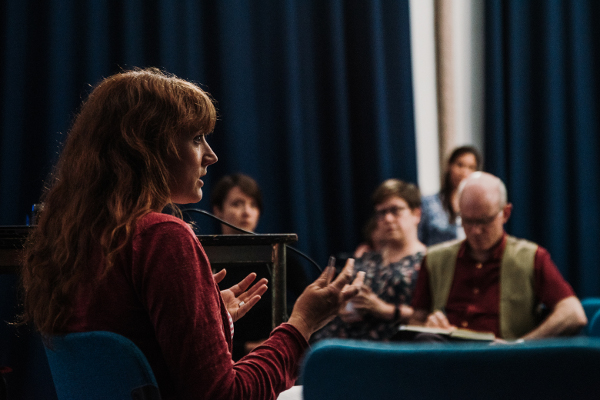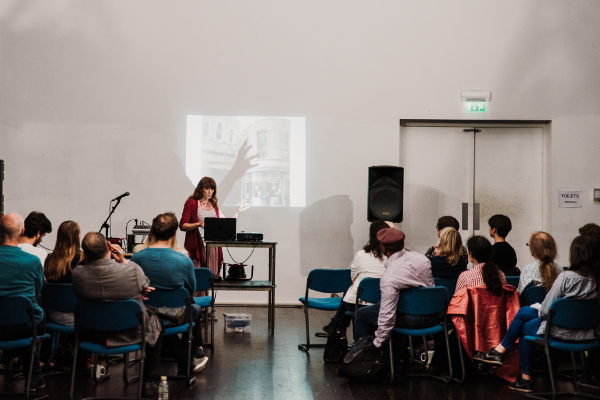From the archive: Same building; different meaning

Dr Katie McClymont's talk '...and The Spirit Lingered On' explored the idea of community spirituality photo@ Khali Ackford
As momentum builds to save Jacob Wells Baths and return the listed building to community use we are looking back at our archive and sharing our blogs exploring the importance of community spaces. In this blog, first published in 2018 as part of our Heart & Soul heritage project, we reflect on Dr Katie McClymont's (UWE’s Senior Lecturer in Urban Planning) public talk about municipal spirituality and its social context.
"Before Katie’s talk I did not understand much about the subject but it was an enormously interesting presentation with many specific examples from around Bristol." Audience member
The talk began with an explanation of the meaning of municipal spirituality and the way it occurs in places with civic and spiritual functions. The term is quite broad and can be applied to music venues, libraries, ex-churches, parks, public spaces and community centres. The factor of whether the space is inside or outside is irrelevant, it is the sense of potential for togetherness or inclusivity that is the key. This feeling does not have to respond to an existing religion, it can be responding to something beyond the everyday realm. For example, cemeteries are not necessarily places of religion but to many people have an enormous sense of the spiritual.
As part of her talk, Katie showed examples of church buildings around Bristol that have been re-purposed. They are all buildings that she happened to be passing on her route around the city on a given day, showing how many church buildings are scattered across the city, and the great proportion of them which are being used for something different than the original purpose.
Katie talked about how, through the 1970s and 1980s, there was an exponential rate of church closures. Some of these still have a social function, such as a former church in Easton that is now a centre for supported independence. Currently the Church of England (C of E) closes around 20-25 churches per each year.
A report from the charity Locality documents this selling buildings and what comminities are doing in response to this.
"I found it very interesting to hear that C of E churches are available for sale, listed on the C of E website for the public to peruse. Some of them have descriptions about their future use, for example ‘for continued worship’, ‘community work’ or ‘suitable for a wide range of uses’." Tess Sieling, project intern
Katie cited the strange feeling around seeing churches for sale in such a matter of fact, straightforward way when in fact they are very special buildings. This raised the question: can you put a price on a church? Also, what judgements are being made about the buildings before they are sold? The example of the Bill’s restaurant chain taking over old church buildings was used, as Katie said that in some cases the insides are ripped out but the strong ethos from the church remains. Even in its new function, sometimes a feeling of the old spirit lingers on. Katie is a very passionate advocate about the amazing idea that churches will always be a place to create connections between people and others; people and the past; and people and something bigger than themselves.
Katie made a film about community art spaces around Bristol including Trinity, Jacobs Wells Baths, Barton Hill Settlement and St Mary Redcliffe Church. As well as being a great medium to communicate the joys of community spaces, Katie said that when they were interviewing people from these spaces, after being asked a question, the interviewee would often give a very telling pause before answering which she believes shows the sense of the community space working beyond its physical and material achievements. Sometimes when churches are changed into private use buildings like a holiday home it can feel wrong and perhaps this is due to that change away from its original ethos. Is it because there is a feeling of loss of the shared community space that once was there?

What is the value of a church when it no longer is a church? Photo credit @Khali Ackford
Sometimes when churches are changed into private use buildings like a holiday home it can feel wrong and perhaps this is due to that change away from its original ethos. Is it because there is a feeling of loss of the shared community space that once was there?
Churches have value. They have a common purpose and a built heritage. The debate is what is their value is and when is it lost? If the value is the sense of people coming together and socialising with people they would not normally, then spaces like Trinity offer us examples of activites that do this with great popularity and with no religious aspect.
Churches closing have caused massive losses to local communities. In addition, a lot of us now live in self selective communities, so where do you meet people different from you apart from in a doctor’s waiting room or on a bus?
Katie's talk highlighted the importance of having inclusive places where different people can engage in a meaningful way. Do we define using a church as a multi use community space as adapting the church or losing the church? As an increasing number of us are of no religion, perhaps we are adapting churches to keep them relevant and concerts, gigs and other actitivites offer us that place to congregate in our secular state.
This write up was by Tess Sieling, who was the project intern on the Heart & Soul heritage project. The talk was part of a series exploring the challenges and achievements of transforming and preserving historic buildings and was programmed in collaboration with Bristol's Architecture Centre and the University of West England (UWE).
How to get involved
Click here to sign the Hotwells and Cliftonwood petition to Save Jacobs Wells Baths
Further reading
Read more from Katie McClymont in her published journal, Spaces for Secular Faith
Read more from our Heart & Soul talk series - Father Paul, Fidel Meraz and A Million Bricks of Love.
Read more about the Save Jacobs Wells Campaign here.




